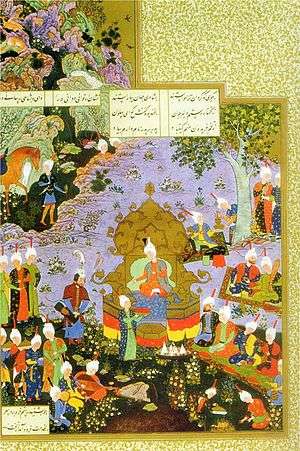Babr-e Bayan
Babr-e Bayān[1] (Persian: بَبْرِ بَیان) or Palangineh (پلنگینه) is the name of a suit that Rostam, the legendary Iranian hero wore in wars. The suit had a number of preternatural features. It was invulnerable against fire, water and weapon. Its color was dark and apparently it was hairy. Rostam, before going to battle, wore three levels of defensive suits, he first put on a zereh, then a gabr or jowshan, and lastly the Babr-e Bayan. According to some verses in Shahnameh, Babr-e Bayan had been made out of the skin of a leopard (the name Palangineh refers to this). This account is also mentioned in some Sogdian texts. According to Faramarznameh, after the death of Rostam, the suit was passed to his son, Faramarz.[1] The story of the armor is part of the five interpolated tales in Shahnameh that demonstrated the extent of Rostam's popularity.[2]
Etymology
The name Babr-e Bayan consists of two components. Babr, the first component, simply means tiger in Middle Persian. Bayan, the second component, is not a Persian word and its origin is uncertain. There are several suggestions for this but none of them are convincing. Some sources referred to the reference to tiger skin (Babre bayan) as a suit that denoted power, influence, and authority.[3]
The Shahnameh did not provide any explanation as to the origin of the armor. However, there are several sources that provide such information. For instance, one an account explained that, when Rostam was 14 years old, he killed a dragon known as Babr-e Bayan in India. The dragon lived in the sea, but he came out of the sea one day every week. When Rostam killed the creature, he made a suit for himself out of its skin. There are similar accounts to this in other Persian epic poems.[1] These were also corroborated by other sources such as an oral version recorded by a German scholar in the 19th century and the prose versions recorded in the collection of tumar (scrolls) that appeared during the Qajar period.[4]
Another suggestion is that Bayan is the name of a city, most probably Bayana in India. Another city named Bayan is also mentioned by early Islamic geographers, the city was located near Tigris in Khuzestan.[1]
References
- Khaleghi-Motlagh, Dj. "BABR-E BAYĀN". ENCYCLOPÆDIA IRANICA. Retrieved 16 March 2016.
- van Zutphen, Marjolijn (2014). Farāmarz, the Sistāni Hero: Texts and Traditions of the Farāmarznāme and the Persian Epic Cycle. Leiden: BRILL. p. 102. ISBN 9789004268265.
- Humphreys, Patrick; Kahrom, Esmail (1999). Lion and Gazelle: The Mammals and Birds of Iran. Gwent, UK: I.B. Tauris. p. 76. ISBN 0951397761.
- Gazerani, Saghi (2015). The Sistani Cycle of Epics and Iran’s National History: On the Margins of Historiography. Leiden: BRILL. p. 72. ISBN 9789004281998.


.png)